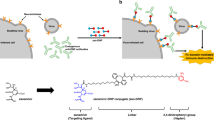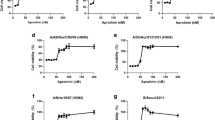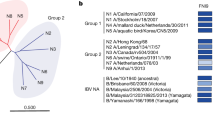Abstract
The threat of a major human influenza pandemic, in particular from highly aggressive strains such as avian H5N1, has emphasized the need for therapeutic strategies to combat these pathogens. At present, two inhibitors of sialidase (also known as neuraminidase), a viral enzyme that has a key role in the life cycle of influenza viruses, would be the mainstay of pharmacological strategies in the event of such a pandemic. This article provides a historical perspective on the discovery and development of these drugs — zanamivir and oseltamivir — and highlights the value of structure-based drug design in this process.
This is a preview of subscription content, access via your institution
Access options
Subscribe to this journal
Receive 12 print issues and online access
$259.00 per year
only $21.58 per issue
Buy this article
- Purchase on SpringerLink
- Instant access to full article PDF
Prices may be subject to local taxes which are calculated during checkout





Similar content being viewed by others
References
Yuen, K. Y. & Wong, S. S. Human infection by avian influenza A H5N1. Hong Kong Med. J. 11, 189–199 (2005).
Maines, T. R. et al. Avian influenza (H5N1) viruses isolated from humans in Asia in 2004 exhibit increased virulence in mammals. J. Virol. 79, 11788–11800 (2005).
Buchy, P. et al. Influenza A/H5N1 virus infection in humans in Cambodia. J. Clin. Virol. 39, 164–168 (2007).
Douglas, R. G. Jr. Prophylaxis and treatment of influenza. N. Engl. J. Med. 322, 443–450 (1990).
Wintermeyer, S. M. & Nahata, M. C. Rimantadine: a clinical perspective. Ann. Pharmacother. 29, 299–310 (1995).
Pinto, L. H., Holsinger, L. J. & Lamb, R. A. Influenza virus M2 protein has ion channel activity. Cell 69, 517–528 (1992).
Hay, A. J. et al. in Options for the Control of Influenza Virus II (ed. Hannoun, C. E.) 281–288 (Excerpta Medica, Amsterdam, 1993).
Hayden, F. G. in Principles and Practice of Infectious Disease (eds Mandell, G. L., Douglas, R. G. J. & Bennett, J. E.) 3–15 (Churchill Livingston, New York, 1993).
Laver, G. & Garman, E. Pandemic influenza: its origin and control. Microbes Infect. 4, 1309–1316 (2002).
Skehel, J. J. & Wiley, D. C. Receptor binding and membrane fusion in virus entry: the influenza hemagglutinin. Annu. Rev. Biochem. 69, 531–569 (2000).
Rich, J. R., Gehle, D. & von Itzstein, M. in Comprehensive Glycoscience: from Chemistry to Systems Biology (eds. Kamerling, J. et al.) (Elsevier, Amsterdam, 2007).
Webster, R. G. et al. in Options for the Control of Influenza Virus II (ed. Hannoun, C.) 177–185 (Excerpta Medica, Amsterdam, 1993).
Wagner, R., Matrosovich, M. & Klenk, H.-D. Functional balance between haemagglutinin and neuraminidase in influenza virus infections. Rev. Med. Virol. 12, 159–166 (2002).
Oxford, J. S. Influenza A pandemics of the 20th century with special reference to 1918: virology, pathology and epidemiology. Rev. Med. Virol. 10, 119–133 (2000).
Herrler, G., Hausmann, J. & Klenk, H.-D. in Biology of the Sialic Acids (ed. Rosenberg, A.) 315–336 (Plenum Press, New York, 1995).
Couceiro, J. N., Paulson, J. C. & Baum, L. G. Influenza virus strains selectively recognize sialyloligosaccharides on human respiratory epithelium; the role of the host cell in selection of hemagglutinin receptor specificity. Virus Res. 29, 155–165 (1993).
Suzuki, Y. et al. Sialic acid species as a determinant of the host range of influenza A viruses. J. Virol. 74, 11825–11831 (2000).
Matrosovich, M. & Klenk, H.-D. Natural and synthetic sialic acid-containing inhibitors of influenza virus receptor binding. Rev. Med. Virol. 13, 85–97 (2003).
Wilson, I. A., Skehel, J. J. & Wiley, D. C. Structure of the haemagglutinin membrane glycoprotein of influenza virus at 3 Å resolution. Nature 289, 366–373 (1981).
Weis, W. et al. Structure of the influenza virus haemagglutinin complexed with its receptor, sialic acid. Nature 333, 426–431 (1988).
Sauter, N. K. et al. Crystallographic detection of a second ligand binding site in influenza virus hemagglutinin. Proc. Natl Acad. Sci. USA 89, 324–328 (1992).
Watowich, S. J., Skehel, J. J. & Wiley, D. C. Crystal structures of influenza virus hemagglutinin in complex with high-affinity receptor analogs. Structure 2, 719–731 (1994).
Colman, P. M. & Ward, C. W. Structure and diversity of influenza virus neuraminidase. Curr. Top. Microbiol. Immunol. 114, 177–255 (1985).
Palese, P., Tobita, K., Ueda, M. & Compans, R. W. Characterization of temperature sensitive influenza virus mutants defective in neuraminidase. Virology 61, 397–410 (1974).
Liu, C., Eichelberger, M. C., Compans, R. W. & Air, G. M. Influenza type A virus neuraminidase does not play a role in viral entry, replication, assembly, or budding. J. Virol. 69, 1099–1106 (1995).
Varghese, J. N., Laver, W. G. & Colman P. M. Structure of the influenza virus glycoprotein antigen neuraminidase at 2.9 Å resolution. Nature 303, 35–40 (1983).
Colman, P. M., Varghese, J. N. & Laver, W. G. Structure of the catalytic and antigenic sites in influenza virus neuraminidase. Nature 303, 41–44 (1983).
Smith, B. J. et al. Structural studies of the resistance of influenza virus neuraminidase to inhibitors. J. Med. Chem. 45, 2207–2212 (2002).
Colman, P. M. Neuraminidase inhibitors as antivirals. Vaccine 20, S55–S58 (2002).
von Itzstein, M. et al. Rational design of potent sialidase-based inhibitors of influenza virus replication. Nature 363, 418–423 (1993).
Kim, C. U. et al. Influenza neuraminidase inhibitors possessing a novel hydrophobic interaction in the enzyme active site: design, synthesis, and structural analysis of carbocyclic sialic acid analogues with potent anti-influenza activity. J. Am. Chem. Soc. 119, 681–690 (1997).
Lentz, M. R., Webster, R. G. & Air, G. M. Site-directed mutation of the active site of influenza neuraminidase and implications for the catalytic mechanism. Biochemistry 26, 5351–5358 (1987).
Chong, A. K., Pegg, M. S., Taylor, N. R. & von Itzstein, M. Evidence for a sialosyl cation transition-state complex in the reaction of sialidase from influenza virus. Eur. J. Biochem. 207, 335–343 (1992).
Tiralongo, J., Pegg, M. S. & von Itzstein, M. Effect of substrate aglycon on enzyme mechanism in the reaction of sialidase from influenza virus. FEBS Lett. 372, 148–150 (1995).
Drzeniek, R. Viral and bacterial neuraminidases. Curr. Top. Microbiol. Immunol. 59, 35–74 (1972).
Flashner, M., Kessler, J. & Tanenbaum, S. W. The interaction of substrate-related ketals with bacterial and viral neuraminidases. Arch. Biochem. Biophys. 221, 188–196 (1983).
Colman, P. M. Influenza virus neuraminidase: structure, antibodies, and inhibitors. Protein Sci. 3, 1687–1696 (1994).
Varghese, J. N., Epa, V. C. & Colman, P. M. Three-dimensional structure of the complex of 4-guanidino-Neu5Ac2en and influenza virus neuraminidase. Protein Sci. 4, 1081–1087 (1995).
Taylor, N. R. & von Itzstein, M. Molecular modeling studies on ligand binding to sialidase from influenza virus and the mechanism of catalysis. J. Med. Chem. 37, 616–624 (1994).
Wilson, J. C. & von Itzstein, M. Recent strategies in the search for new anti-influenza therapies. Curr. Drug Targets 4, 389–408 (2003).
Colman, P. M. et al. Preparation of 2-deoxy-N-acetylneuraminic acid derivatives as antiviral compounds which bind the active site of influenza neuraminidase. Patent WO9206691 (1992).
Palese, P., Schulman, J. L., Bodo, G. & Meindl, P. Inhibition of influenza and parainfluenza virus replication in tissue culture by 2-deoxy-2,3-dehydro-N-trifluoroacetylneuraminic acid (FANA). Virology 59, 490–498 (1974).
Palese, P. & Compans, R. W. Inhibition of influenza virus replication in tissue culture by 2-deoxy-2,3-dehydro-N-trifluoroacetylneuraminic acid (FANA): mechanism of action. J. Gen. Virol. 33, 159–163 (1976).
Palese, P. & Schulman, J. L. in Chemoprophylaxis and Viral Infections of the Respiratory Tract (ed. Oxford, J. S.) 189–205 (CRC Press, Cleveland, 1977).
Nöhle, U., Beau, J. M. & Schauer, R. Uptake, metabolism and excretion of orally and intravenously administered, double-labeled N-glycoloylneuraminic acid and single-labeled 2-deoxy-2,3-dehydro-N-acetylneuraminic acid in mouse and rat. Eur. J. Biochem. 126, 543–548 (1982).
von Itzstein, M. et al. A study of the active site of influenza virus sialidase: an approach to the rational design of novel anti-influenza drugs. J. Med. Chem. 39, 388–391 (1996).
Goodford, P. J. A computational procedure for determining energetically favorable binding sites on biologically important macromolecules. J. Med. Chem. 28, 849–857 (1985).
von Itzstein, M., Wu, W.-Y. & Jin, B. The synthesis of 2,3-didehydro-2,4-dideoxy-4-guanidinyl-N-acetylneuraminic acid: a potent influenza virus sialidase inhibitor. Carbohydr. Res. 259, 301–305 (1994).
Holzer, C. T. et al. Inhibition of sialidases from viral, bacterial and mammalian sources by analogues of 2-deoxy-2,3-didehydro-N-acetylneuraminic acid modified at the C-4 position. Glycoconj. J. 10, 40–44 (1993).
Woods, J. M. et al. 4-Guanidino-2,4-dideoxy-2,3-dehydro-N-acetylneuraminic acid is a highly effective inhibitor both of the sialidase (neuraminidase) and of growth of a wide range of influenza A and B viruses in vitro. Antimicrob. Agents Chemother. 37, 1473–1479 (1993).
Li, C. Y. et al. A nonsynonymous SNP in human cytosolic sialidase in a small Asian population results in reduced enzyme activity: potential link with severe adverse reactions to oseltamivir. Cell Res. 17, 357–362 (2007).
Mann, M. C. et al. Unsaturated N-acetyl-D-glucosaminuronic acid glycosides as inhibitors of influenza virus sialidase. Glycoconj. J. 23, 127–133 (2006).
Babu, Y. S. et al. BCX-1812 (RWJ-270201): discovery of a novel, highly potent, orally active, and selective influenza neuraminidase inhibitor through structure-based drug design. J. Med. Chem. 43, 3482–3486 (2000).
DeGoey, D. A. et al. Enantioselective synthesis of antiinfluenza compound A-315675. J. Org. Chem. 67, 5445–5453 (2002).
Kim, C. U. et al. Structure–activity relationship studies of novel carbocyclic influenza neuraminidase inhibitors. J. Med. Chem. 41, 2451–2460 (1998).
Le, Q. M. et al. Avian flu: isolation of drug-resistant H5N1 virus. Nature 437, 1108 (2005).
Okumura, A. et al. Oseltamivir and delirious behavior in children with influenza. Pediatr. Infect. Dis. J. 25, 572 (2006).
Russell, R. J., et al. The structure of H5N1 avian influenza neuraminidase suggests new opportunities for drug design. Nature 443, 45–49 (2006).
Tsai, C. H., Lee, P. Y., Stollar, V., Li, M. L. Antiviral therapy targeting viral polymerase. Curr. Pharm. Des. 12, 1339–1355 (2006).
De Clercq, E. & Neyts, J. Avian influenza A (H5N1) infection: targets and strategies for chemotherapeutic intervention. Trends Pharmacol. Sci. 28, 280–285 (2007).
Ilyushina, N. A. Bovin, N. V., Webster, R. G. & Govorkova, E. A. Combination chemotherapy, a potential strategy for reducing the emergence of drug-resistant influenza A variants. Antiviral Res. 70, 121–131 (2006).
Hasegawa, H. et al. Development of a mucosal vaccine for influenza viruses: preparation for a potential influenza pandemic. Expert Rev. Vaccines 6, 193–201 (2007).
Carrat, F. & Flahault, A. Influenza vaccine: the challenge of antigenic drift. Vaccine 25, 6852–6862 (2007).
Varghese, J. N., McKimm-Breschkin, J. L., Caldwell, J. B., Kortt, A. A. & Colman P. M. The structure of the complex between influenza virus neuraminidase and sialic acid, the viral receptor. Proteins 14, 327–332 (1992).
Burmeister, W. P. et al. Influenza B virus neuraminidase can synthesize its own inhibitor. Structure 1, 19–26 (1993).
Zechel, D. L. & Withers, S. G. Dissection of nucleophilic and acid-base catalysis in glycosidases. Curr. Opin. Chem. Biol. 5, 643–649 (2001).
Wallace, A. C., Laskowski, R. A. & Thornton, J. M. LIGPLOT: a program to generate schematic diagrams of protein-ligand interactions. Protein Eng. 8, 127–134 (1995).
Acknowledgements
The Australian Research Council is acknowledged for its generous support through the award of a Federation Fellowship. J. Dyason is thanked for providing a number of the computer-generated graphics and for reading this manuscript.
Author information
Authors and Affiliations
Related links
Related links
DATABASES
Swissprot ENZYME
FURTHER INFORMATION
Rights and permissions
About this article
Cite this article
von Itzstein, M. The war against influenza: discovery and development of sialidase inhibitors. Nat Rev Drug Discov 6, 967–974 (2007). https://doi.org/10.1038/nrd2400
Issue date:
DOI: https://doi.org/10.1038/nrd2400
This article is cited by
-
CRISPR/Cas9-assisted ssDNA recombineering for site-directed mutagenesis and saturation mutagenesis of plasmid-encoded genes
Biotechnology Letters (2023)
-
Escherichia coli BL21(DE3) optimized deletion mutant as the host for whole-cell biotransformation of N‑acetyl‑d‑neuraminic acid
Biotechnology Letters (2023)
-
Gangliosides as Siglec ligands
Glycoconjugate Journal (2023)
-
Structure of the catalytically active APOBEC3G bound to a DNA oligonucleotide inhibitor reveals tetrahedral geometry of the transition state
Nature Communications (2022)
-
A study on catalytic and non-catalytic sites of H5N1 and H1N1 neuraminidase as the target for chalcone inhibitors
Applied Biological Chemistry (2021)



